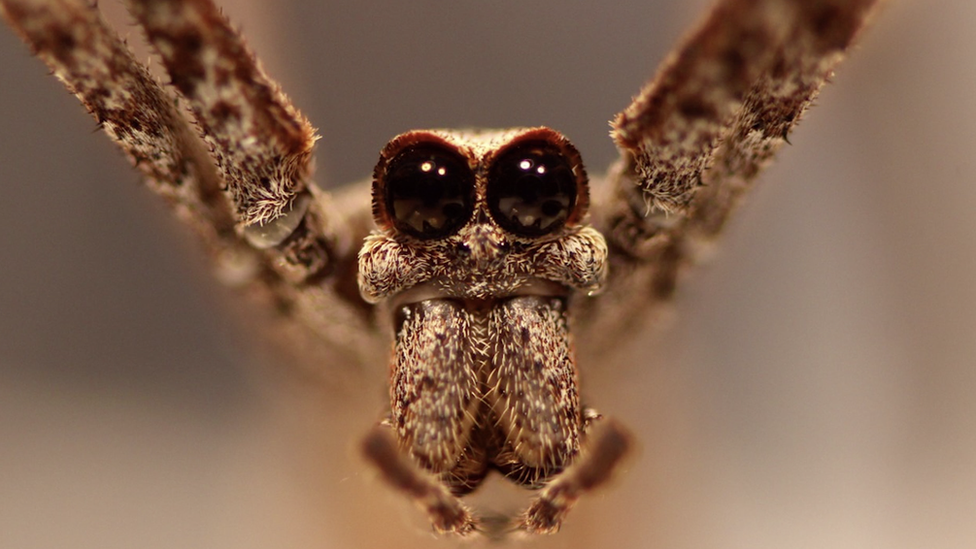Ogre-faced spiders can hear with their legs
- Published
- comments

Massive eyes and legs that can hear.... is this the coolest spider ever?!
Whilst this image might be the stuff of nightmares, a Halloween film, or an alien invasion... we're sorry to tell you that this spider is VERY real, but have no fear - it's also pretty cool!
Because this spider can hear... with it's legs.
Scientists at Cornell university have found that ogre-faced net-casting spiders use sensors at the tip of their legs to detect a wide range of sounds up to 6 feet away. It's an unique ability not seen in other spiders.
This sensor triggers a split-second, ninja-like backflip to strike unsuspecting flying insects.
The ogre-faced species creates a web shaped like the letter A
"Coolest spiders on the planet"
The ogre-faced arachnids are found mostly in the south-eastern United States.
They are nocturnal creatures - which means they are active at night and do very little during the day - and have the biggest eyes of any spider.
They also have unique hunting behaviour and are "some of the coolest spiders on the planet," said Jay Stafstrom, a sensory ecologist at Cornell University in the US.
The spiders make a fuzzy rectangular net within the A-shaped frame which they hold with their front four legs. They can catch prey walking beneath them or flying above them in this web
While people are familiar with spiders that create orb webs, this species makes an unusual "frame web" shaped like the letter A, then makes a fuzzy rectangular net to catch its prey.
They don't have ears, but can sense a wide range of sounds thanks to the metatarsal organ - which are sensors at the tip of their legs.
But despite the vibration-sensing hairs and receptors on most arachnids' legs, scientists long thought spiders couldn't hear sound as it travelled through the air, but instead felt vibrations through surfaces.
But with the ogre-faced spider, the sensors act like ears, picking up different sound waves.
Our spidey senses are tingling! Is this guy giving you inspiration for next year's Halloween costume?
What else did the scientists find?
What surprised the team was how well the ogre-faced spider can hear.
The spider is able to get information on the sound, direction and distance of a flying bug - and then catch it.
To determine how much of this relied on eyesight, Stafstrom placed a tiny blindfold over the spiders' eyes. Although they could not capture bugs on the ground, they could still catch a meal mid-flight.
As well as GINORMOUS eyes, the ogre-faced spider has incredible hearing
So Stafstrom tried playing different pitches of sound to the spiders and saw that their brains and leg sensors became active for different tones.
The team discovered that these spiders can detect the low-frequency sounds of an insects wings and high-frequency bird calls.
"While the spiders were sensitive to low-frequency tones, as expected... we didn't really expect to see net-casting spiders sensitive to a wide range of frequencies - all the way to 10 kilohertz." said Stafstrom
"It's totally unique... These spiders have massive eyes so they can see at night and catch things off the ground, but they can 'hear'' quite well, detecting sound through their metatarsal organ, as these spiders excel at catching things from the air."
- Published29 October 2020
- Published28 October 2020
- Published29 October 2020
